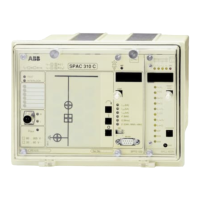21
Over the SPA bus substation level data commu-
nicator can read the event data, change in status,
produced by the control module SPTO 1D2.
The events are represented by the event codes
e.g. E1…E11. The control module transmits its
event data in the format:
<time> <channel number><event code>
where time = ss.sss (seconds and parts of
second)
channel number = 0...13
event code = E1...E54, depending on
the channel
Most of the event codes and the events repre-
sented by these may be included in or excluded
from the event reporting by writing an event
mask (V155) to the module. The event mask is
a binary number coded to a decimal number.
Each channel (0...13) has its own event mask.
Each event code is represented by a number. An
event mask is formed by multiplying the number
either by 1, which means that event is included
in the reporting, or by 0, which means that event
is not included in the reporting, and finally
adding up the results of multiplications.
Event codes
Example 17: Calculation of the event mask.
Channel Event Event Number Event Result of
code represen- factor multipli-
ting the cation
event
2 E1 Change in status: xx ->10 (open) 1 x 1 = 1
2 E2 Change in status: xx ->01 (close) 2 x 1 = 2
2 E3 Change in status: xx ->11 (undefined) 4 x 0 = 0
2 E4 Change in status: xx ->00 (undefined) 8 x 1 = 8
2 E5 OPEN output activated 16 x 1 = 16
2 E6 OPEN output reset 32 x 0 = 0
2 E7 CLOSE output activated 64 x 1 = 64
2 E8 CLOSE output reset 128 x 0 = 0
2 E9 Output activation inhibited 256 x 1 = 256
2 E10 Output activation fault 512 x 0 = 0
2 E11 Attempt to activate an output 1024 x 0 = 0
without open/close selection
Event mask V155 for channel 2 347
The event mask V155 of channel 0 and channels
4…13 may have a value within the range 0…15
and the event mask of channels 1…3 within the
range 0…2047. The default values are shown in
the next table.
Channels 1...13 have a setting S20, which ena-
bles or inhibits the event reporting of the corre-
sponding channel. The default value is 0, which
means that event reporting is allowed according
to event mask.
The settings S10...S13 for channels 1...3 and
settings S10 and S11 for channels 4…13 define
the event delays. The event delays are used for
filtering out unwanted events when status data
is changing. An event code is generated only if
the status data is stable for a longer time than the
corresponding delay time, e.g. the event code E4
"change in status: xx -> 00" can be filtered out
when the status of an object is changing from
open to close and vice versa. The time marking
of a delayed event is the actual event time added
with the delay time.

